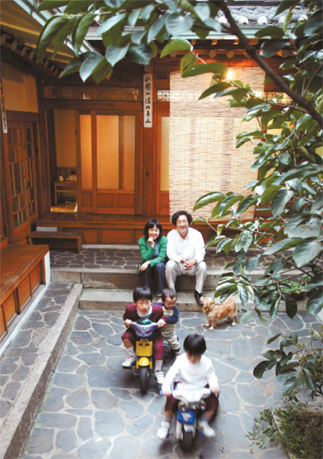The man behind hanok revival

Architect Jo Jeong-gu has been building or remodeling hanok - traditional homes - across the country since 2001. His family also moved to a hanok in the Seodaemun-gu area in Seoul in 2003. [JoongAng Ilbo]
A man who deserves a fair share of credit for the newfound popularity of hanok, or traditional Korean homes, is Jo Jeong-gu, the director at Guga Architects. He has renovated or built more than 30 hanok across Korea that have now become landmarks in more ways than one. A graduate in architecture of the prestigious Seoul National University, Jo opened his first office, Guga Architects, in 2000. A year later he worked on the hanok renovation project in Bukchon, northern Seoul, which gave birth to the Bukchon Hanok Village, now a tourist destination.
Since Bukchon, Jo says he has fallen in love with hanok. So much so that in 2003 Jo and his wife moved to a hanok in the Seodaemun-gu area of Seoul. Before that the couple and their only child lived in a typical Korean apartment building. Now, Jo and his wife have four kids, which they say must have something to do with the peace of mind that comes with living in a hanok.
“I don’t necessarily believe that a hanok must be a traditional wooden structure,” Jo said. “But I do believe the most important thing in a hanok is its relationship with the courtyard. That is where the true ‘hanokness’ comes from: the yard.”
Jo went on to say that a hanok’s yard is not something that people just look at and enjoy visually. It is something that people use, where they can actually feel the seasons change.
“Getting a yard is like getting a piece of nature in a huge room,” Jo said.
One of Jo’s most high-profile projects was the multiple award-winning La Gung hotel. La Gung opened in 2007 and enjoyed intense media coverage, as it was the first high-end, luxury hanok hotel to open in Korea. Jo admits he wasn’t certain La Gung would succeed when he was first given the job. After all, it was an unprecedented project.
“My biggest concern when designing La Gung was how many traditional elements I would use and how much I would adopt modern functions,” he said.
In its completed form, La Gung embodies the qualities that set Jo apart from other hanok-savvy architects: It retains its traditional form yet has modern functions and facilities.
Each villa at the hotel has two to three rooms and a private yard as well as a private, open-air hot bath. After La Gung, Jo worked on another hanok hotel, a hanok library and a hanok art gallery. But the architect says he is most inspired by residential hanok. He names a hanok in Gahoe-dong called Seoneumjae as one of his most memorable projects. Built in 1934, the hanok was on the verge of being demolished, with the owner - like so many who came before - tempted by a large offer from a real estate developer. But Jo heard about Seoneumjae and its historical value and convinced the owner to opt for renovation instead.
“I thought about what the best renovated hanok I’ve ever worked on was,” Jo said. “It was, in fact, my house. I have lived in a hanok since 2003, but I didn’t renovate it too much. That’s when I realized that when it comes to hanok renovation, less is more.”
Although Jo focused on keeping the original frame and ambiance of Seoneumjae, he did add elements to make life there more convenient. Still, Jo made sure the building’s 70-year heritage was kept as intact as possible.
“Today, so many things are disappearing,” Jo lamented. “Even before we get to look at or talk about what we have, our cities get demolished and erased. We need to come up with a way to bring development to cities without erasing.”
By Lee Eun-joo, Kim Hyung-eun [hkim@joongang.co.kr]










with the Korea JoongAng Daily
To write comments, please log in to one of the accounts.
Standards Board Policy (0/250자)